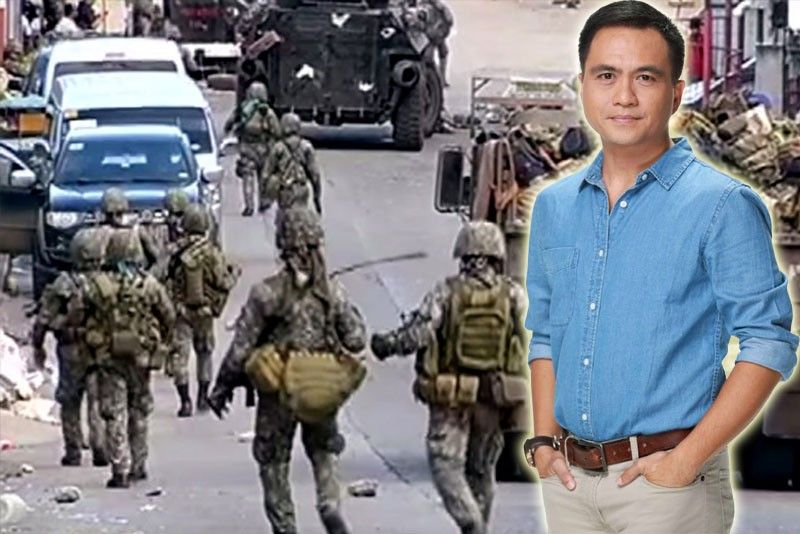Jun Veneracion, one year after Marawi siege coverage

MANILA, Philippines — One year after the Marawi siege, veteran reporter Jun Veneracion revealed behind-the-scenes stories of covering the months-long armed conflict between government forces and Maute-ISIS militants, which resulted to unimaginable destruction in the Islamic city.
Reporting from the ground and staying a good two months in Marawi, Jun was GMA network’s main man in delivering stories that somehow allowed viewers a better grasp of the depth and dimensions of the crisis.
One was his exclusive report during the earlier part of the siege about civilians being killed by the Maute-ISIS terrorists, as evidenced by a photo he obtained from a source. It was a scoop that raised doubt and caused even some security officials to dismiss it as fake news.
Jun recalled, “I got the photo minutes before the newscast. Ako yung Take 1 sa newscast. When we went to Marawi, we had a slight idea kung ano ang dadatnan namin but we didn’t know how enormous the problem was. Then, this photo came out, forwarded to me. Sabi ko, ang daming patay (so many dead bodies)! That time, nine was many already right? Sabi ko, ang dami na nito, let’s break this story. But I really had to make sure (that it was true).”
Knowing very well that his job and credibility were on the line, the TV journo remembered how scared he was before reporting on it. “I was also afraid of the possible repercussions. No. 1, what if kung mali? I mean that photo was fed to me by a source. Pero bago ko siya nilabas, lahat ng klaseng tanong ginawa ko, ‘Nakikita mo ba ang nakikita ko sa litrato na ‘to?,’ sabi ko sa kanya. That source was on the field meters away from the cadavers. But what if this photo already came out months ago? Tapos na ako di ba (I’m done, right)? My career would be over.”
He went ahead and released the photo in his report. It put a definitive face on the Marawi siege coverage and was subsequently picked up by other media, including foreign news outlets.
“But a day after that, marami nagko-contest, especially security officials, ‘Baka fake yan eh?’ So, I told my source, give me a photo that you took yourself,” he said as the photo was only given to his source by a resident. “During that time, nakikita nila from a distance of about 100 to 200 meters, pero di nila malapitan because the area was open. That was the time when snipers were all over the place, so to speak. Pinadalhan niya ako ng photo and dun ako nakahinga ng maluwag (My source sent me a photo and that was the time I was able to heave a sigh of relief).”
According to him, landing a scoop is a result from years of pounding the same beat and building a network of sources. “It’s particularly difficult if you’re new to the area because it’s not going to be delivered to you on a silver platter; it comes with trust and confidence. Hindi siya pwedeng ibigay sayo ng ganun-ganun lang. Grabe naman hindi mo pinaghirapan. I mean, we call them parachute journalists, (they’re those) who’d suddenly enter an area expecting manna from heaven. You have to work hard for it.”
Knowing the person you’re facing or dealing with spells a huge difference, he said. Through the many years of working with his sources, he continued, you get to develop a level of trust and confidence like no other. “Sometimes, there’s personal attachment, magiging ka-tropa kayo, but of course, you have to draw the line,” he stressed.
Drawing the line allowed him to file another exclusive report that somehow cast the military in a negative light during the tail-end of the Battle of Marawi.
“Medyo inabot ako ng sangkatutak na criticism from my sources because I released one story. This was during the tail-end of the coverage. Di ba ang taas ng tingin sa mga sundalo? There was this one video that a source gave me and it was about military atrocity... Binubugbog nila, mukhang kawawa pero di ko naman alam kung anong ginawa nun, bakit ginawa yun. But it was pretty obvious from the video he was at the receiving end of kicks, punches and all.
“When I released that, sometimes, short of calling me a traitor, one top military official told me, binigay ko sa ‘yo halos lahat, ginanyan mo pa ako (I gave you almost everything but you still did that to me).”
Jun related that he lost sleep days after but he reassured himself that these were his friends and they were just letting out steam. “I just let them be. Maybe they had the right to do so, because you were able to establish a good working relationship. Pero paliwanag ko, trabaho lang, sir, di naman lagi tayo magkakampi.”
What he went through in Marawi though was nothing compared to what he experienced in his Basilan coverage in 2007.
Embedded with the Marines in a search and rescue operation in Basilan, Jun and his news team were caught in the middle of a nine-hour firefight between rebels and the military. Compounding the problem was the malfunctioning equipment of the military frontliners.
“It’s really a different (story) when you are covering and you are on the receiving end of the gunfire. They were really not targeting media. We were the only group of journalists there, but nandun ka sa group ng military forces. The other side didn’t care (if you were media or not).”
The story behind this dramatic news coverage was eventually told through a documentary produced by Reporter’s Notebook. Jun’s report went on to win the 2008 New York Festivals Bronze World Medal for Coverage of an On-going Story.
But at that time, he couldn’t help but think that they were a goner. He further recounted, “First thing I thought, what if something bad would happen to my companions, because I was the leader of the team eh, and then our deployment was based on the information that I got that there was going to be a rescue operation so I was able to bring my team there. That was my biggest concern, that something bad would happen to them. What would I tell their families? Maybe, second na yung sa akin, sa sarili ko.
“Me, I’m not a prayerful person but that very moment, all the possible prayers that could be said, I did. I was prepared to go after saying all the prayers. Thank God, hindi!” he could now look back with a laugh.
It became a huge learning experience though for Jun, which he has since applied in his succeeding war coverages. He shared, “Mas naging takot ako... You become cautious, you become deliberate (in your actions). Like in this kind of coverage, you don’t always have to be moving forward. Sometimes, you have to stop and think kung ano ang aabutin mo. I brought that to my Marawi coverage.”
Another lesson he brought to Marawi was to be sensitive to the people and place that have become the subject of their reports.
There were certain media people criticized for doing Facebook Live and taking selfies with the Marawi devastation serving as background. Jun experienced calling out a fellow reporter for doing so.
“You will learn that through years of experience. The backstory for that, kung bakit dapat yung mentality mo is you should have respect for the place (of your coverage), many journalists were criticized during the Zamboanga siege because ginagawa nilang background ang ruins. Buhay yun eh, pinaghirapan ng mga tao yun. These are shattered dreams and lives and then you just turn them into a backdrop for your selfie? Learning from that, we brought it with us to (Marawi). Those are coverage intricacies that you won’t learn in school at times, but rather on the field.”
Reporting on wars has been quite an eye-opener, Jun said. “They say covering wars is sexy or macho kuno; ang lakas ng dating kasi naka-vest ka. But more than that, magiging exposed ka, magiging eye-opener siya na hindi lang yung the sounds of war, pero yung mga aspects din na nagtutulak bakit nagkaroon ng mga ganun.”
His field of expertise, particularly military and defense, was one of the reasons he was tapped to assume the position of permanent host in the multi-awarded Reporter’s Notebook vacated by Jiggy Manicad, who reportedly has decided to go into politics.
Incidentally, he is celebrating his 15th year with GMA 7. The journalism graduate from the University of Sto. Tomas moved to the network in 2003 after a decade spent with IBC-13.
Asked how he felt about his new assignment, Jun said, “Happy because napaka-limited ng slot namin, yung pyramid ba? Pag nandun sa taas, ang sikip na niya? So to be given this kind of opportunity... this is really a big deal for me.”
- Latest
- Trending

























 Exclusive
Exclusive





